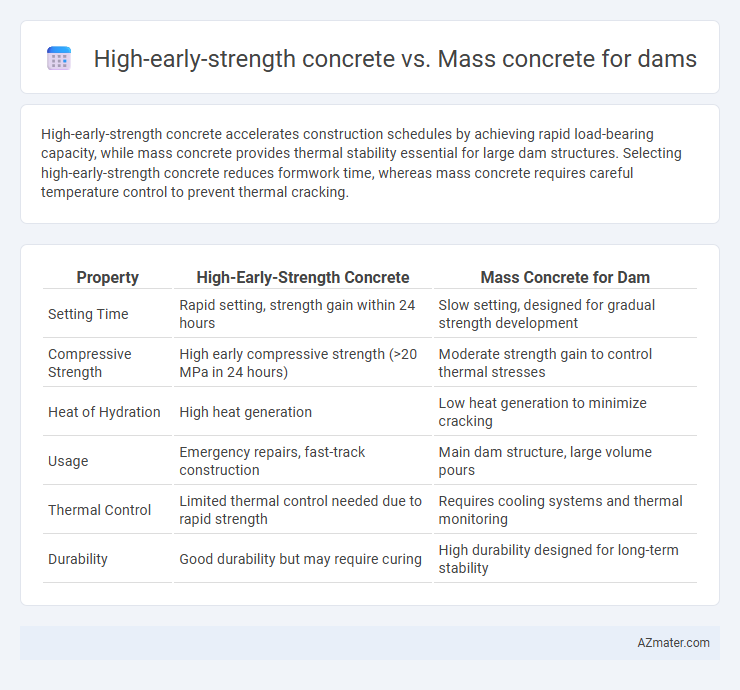High-early-strength concrete accelerates construction schedules by achieving rapid load-bearing capacity, while mass concrete provides thermal stability essential for large dam structures. Selecting high-early-strength concrete reduces formwork time, whereas mass concrete requires careful temperature control to prevent thermal cracking.
Table of Comparison
| Property | High-Early-Strength Concrete | Mass Concrete for Dam |
|---|---|---|
| Setting Time | Rapid setting, strength gain within 24 hours | Slow setting, designed for gradual strength development |
| Compressive Strength | High early compressive strength (>20 MPa in 24 hours) | Moderate strength gain to control thermal stresses |
| Heat of Hydration | High heat generation | Low heat generation to minimize cracking |
| Usage | Emergency repairs, fast-track construction | Main dam structure, large volume pours |
| Thermal Control | Limited thermal control needed due to rapid strength | Requires cooling systems and thermal monitoring |
| Durability | Good durability but may require curing | High durability designed for long-term stability |
Introduction to High-Early-Strength Concrete and Mass Concrete
High-early-strength concrete is designed to achieve rapid strength gain within 24 to 72 hours, making it ideal for accelerating construction schedules and reducing formwork time in dam projects. Mass concrete, characterized by large volume pours exceeding 1 cubic meter, requires careful thermal control to manage heat of hydration and prevent cracking during curing. Understanding the distinct properties and applications of high-early-strength and mass concrete is essential for optimizing structural performance and durability in dam construction.
Key Material Properties and Composition
High-early-strength concrete for dams incorporates rapid-hydrating cement types and finely graded aggregates, achieving strength gains above 20 MPa within 24 hours, essential for accelerated construction schedules. Mass concrete utilizes low-heat Portland cement blended with pozzolans like fly ash or silica fume to reduce thermal cracking by controlling heat of hydration and minimizing shrinkage, with typical 28-day strengths around 30-40 MPa. The key material properties differentiate in thermal conductivity, heat generation, and curing requirements, impacting long-term durability and structural integrity in large-volume dam applications.
Setting Time and Strength Development
High-early-strength concrete achieves rapid setting times within 3 to 6 hours, enabling early load application and reducing construction time for dam structures. Mass concrete typically exhibits slower setting, often extending beyond 12 hours, which helps mitigate thermal cracking due to heat generation in large volumes. Strength development in high-early-strength concrete reaches 20 to 30 MPa within 24 hours, while mass concrete focuses on controlled strength gain over days to weeks to ensure structural durability and stability.
Thermal Characteristics and Heat of Hydration
High-early-strength concrete for dams exhibits accelerated hydration kinetics, resulting in a faster development of strength but generating significant heat of hydration that may increase thermal gradients and risk of cracking. Mass concrete, designed for large volume pours, emphasizes controlled heat of hydration through low-heat cement and admixtures to minimize temperature differentials and thermal stresses within the structure. Effective management of thermal characteristics in both types is critical for structural integrity and durability of dam constructions.
Construction Techniques and Placement Methods
High-early-strength concrete accelerates dam construction by reducing curing time, enabling faster formwork removal and early load application, which is crucial in projects with tight schedules. Mass concrete requires controlled placement techniques such as layer-by-layer pouring and the use of chillers or cooling pipes to mitigate thermal cracking caused by heat of hydration. Placement methods for high-early-strength concrete often involve pumps and rapid setting admixtures to ensure uniformity and minimize delays, whereas mass concrete emphasizes continuous placement and temperature control to maintain structural integrity.
Structural Performance in Dam Applications
High-early-strength concrete offers rapid strength gain that minimizes formwork removal time and accelerates construction schedules in dam applications, crucial for early load resistance and stability. Mass concrete, designed to manage thermal stresses through controlled heat of hydration, provides superior durability and minimizes cracking risks in large-volume placements typical of dam structures. Optimizing mix designs for thermal control in mass concrete enhances long-term structural performance by reducing thermal gradients and associated mechanical stresses.
Durability and Long-Term Behavior
High-early-strength concrete achieves rapid strength gain, enhancing early load-bearing capacity and reducing construction time, but may induce higher internal stresses that affect long-term durability. Mass concrete for dams relies on slower curing processes to minimize thermal cracking and ensure structural stability over decades, promoting superior resistance to chemical attacks and freeze-thaw cycles. The long-term behavior of mass concrete demonstrates enhanced durability through controlled hydration and reduced permeability, essential for maintaining the integrity of large-scale dam structures.
Cost Implications and Economic Considerations
High-early-strength concrete reduces construction time and accelerates project schedules, potentially lowering labor and equipment costs for dam construction. Mass concrete, while slower to cure, offers enhanced thermal control and durability, minimizing risks of thermal cracking that could lead to costly repairs. Evaluating the balance between upfront material costs and long-term maintenance expenses is crucial for optimizing the economic efficiency of dam projects.
Environmental Impact and Sustainability
High-early-strength concrete reduces construction time for dams, lowering overall carbon emissions by minimizing energy consumption during curing and allowing faster project turnover. Mass concrete uses larger volumes and typically requires longer curing periods, increasing the environmental footprint due to prolonged cement hydration and higher greenhouse gas emissions. Sustainable dam construction favors high-early-strength concrete to optimize resource efficiency and reduce long-term ecological impacts.
Best Practices for Selecting Concrete Type in Dam Construction
High-early-strength concrete accelerates the construction schedule by achieving required strength rapidly, making it ideal for sections subjected to early load or emergency repairs in dam construction. Mass concrete demands careful temperature control and low heat cement to prevent thermal cracking due to its large volume and slow cooling rates, ensuring structural integrity over extended curing periods. Best practices involve evaluating project timelines, thermal stress management, and structural requirements to select the appropriate concrete type that balances strength development and durability in dam environments.

Infographic: High-early-strength concrete vs Mass concrete for Dam
 azmater.com
azmater.com